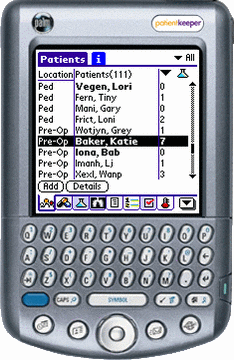|
|

A
47-year-old man presents to the emergency department (ED)
with severe left shoulder pain and intermittent fevers for
1 week. He reports diffuse joint discomfort, most notably
in his left shoulder, and in his toes. He was examined in
the ED yesterday. Acetaminophen-hydrocodone was prescribed
but provided no relief. He denies using injected drugs. His
wife adds that they were "getting a lot of fleabites
at home." Although their dog died from "old
age" about 3 weeks ago, they still have fleas in the
house. She wants to know if rats can carry fleas because
they bought a pet rat about 2 weeks ago.
On physical examination, the patient has a fever
(temperature, 101.3°F [38.5°C]), but the rest of his
vital signs are normal. His left wrist is resting between
opened buttons of his shirt as a makeshift sling, and he
demonstrates clinically significant guarding of the left
shoulder. His shoulder is tender but not red or swollen. He
also has a maculopapular rash on his legs (see Image 1)
without distinct lesions suggestive of insect bites. He has
a well-healed bite mark on his left index finger; the area
is not tender or erythematous (see Image 2). Other physical
findings are unremarkable.

The patient's blood work is notable only for a WBC of 15.7
X 109/L. A CT scan of the shoulder is obtained
to evaluate for an effusion and a possible septic joint. No
effusion is present, but calcium deposits are seen in the
bicipital groove.
Is calcific tendonitis consistent with this patient's
presentation? What is the etiology of the patient's fever?
Answer
Rat-bite
fever: Rat-bite fever is a rarely diagnosed
infection. In the United States, the most frequent
cause of rat-bite fever is Streptobacillus
moniliformis, a fastidious gram-negative
bacterium commonly carried by healthy rodents,
including pets and laboratory animals. In Asia, most
cases are due to Spirillum minus, a
gram-negative, coiled rod also carried by rodents.
Infection may occur not only from bites by colonized
animals but also from a scratch or from fecal-oral
transmission. Incubation is typically 2-10 days, and
symptoms usually begin abruptly, with fever, chills,
severe migratory arthralgias and myalgias, vomiting,
and headache. Young children may have diarrhea and
weight loss. After 2-4 days after these symptoms
appear, patients have a maculopapular, petechial,
morbilliform, pustular, or vesicular rash on their
extremities, including the palms and the soles.
Symptoms may be most severe in the lower
extremities, and fever may resolve and relapse in an
irregular fashion. Evidence of the bite itself is
often absent by the time the patient presents.
Regional lymphadenopathy is present in only S
minus infections.
Complications of rat-bite fever include focal
abscesses, pneumonia, meningitis, endocarditis,
myocarditis, anemia, and multiorgan failure. Death
has been reported in as many as 13-25% of untreated
patients. Up to one half of patients develop septic
arthritis or asymmetric polyarthritis.
The diagnosis is based on clinical findings and
confirmed with blood cultures. S moniliformis
requires 10-20% serum medium and an environment with
5-10% carbon dioxide for optimal growth. Even under
these conditions, this organism may take as long as
20 days to grow. Sodium polyanethol sulfonate, an
anticoagulant, can inhibit bacterial growth if
present in culture bottles. Patients typically have
a marked leukocytosis with a leftward shift. As many
as 25% of patients have false-positive serologic
results for syphilis.
The treatment of choice for rat-bite fever is
intravenous penicillin in doses of 200,000 U given
every 4 hours for 7 days. This is followed by oral
penicillin 500 mg given 4 times a day for an
additional 7 days. In patients with penicillin
allergy, doxycycline 100 mg given orally twice a day
is the recommended alternative. S moniliformis
is also usually sensitive to ampicillin, cefotaxime,
and azithromycin. Prophylaxis for rat bites should
include aggressive cleansing of the bite wound,
prophylactic antibiotics taken for 3 days,
immunization with tetanus toxoid if indicated, and
regular wound care. No known cases of
rat-transmitted rabies have been reported in the
United States; therefore, prophylaxis is not
recommended here.
|
Link
to further Information on:

For
more information on rat-bite fever, see the eMedicine
articles Fever
of Unknown Origin (within the Internal Medicine
specialty) and Animal
Bites (within the Otolaryngology and Facial Plastic
Surgery specialty).
|
|







 DISCLAIMER:
This website is designed primarily for use by qualified
physicians and other medical professionals. The
information provided here is for educational and
informational purposes only. It is not guaranteed to be
correct and should NOT be considered as a substitute for
the advice of an appropriately qualified expert. In no way
should the information on this site be considered as
offering advice on patient care decisions or establishment
of a patient-physician relationship.
DISCLAIMER:
This website is designed primarily for use by qualified
physicians and other medical professionals. The
information provided here is for educational and
informational purposes only. It is not guaranteed to be
correct and should NOT be considered as a substitute for
the advice of an appropriately qualified expert. In no way
should the information on this site be considered as
offering advice on patient care decisions or establishment
of a patient-physician relationship.